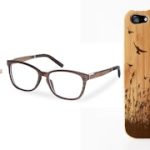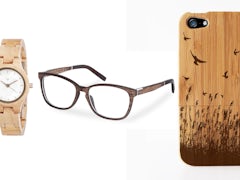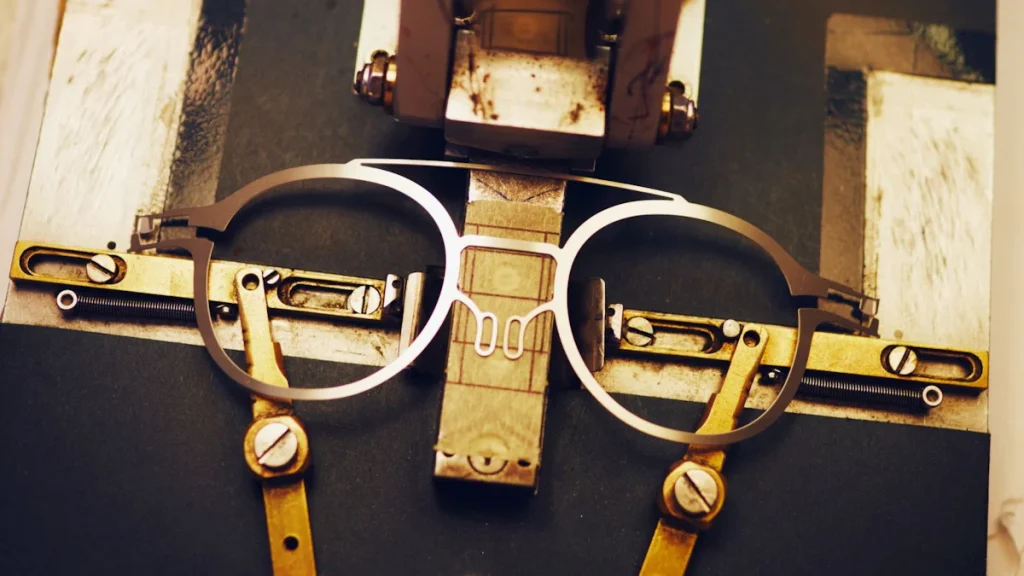

The “Jack” model from the eyewear brand ic! berlin, founded by Harald Gottschling and Philipp Haffmans (the two design students) and Ralph Anderl (the PR shaman with cultural education training), was a perfect fit. The frame, developed in 1996, was punched out of thin sheet metal and fixed without any screws; the hinges were simply cleverly fitted together. Jack weighed 20 grams and looked as if a pair of poisonous yellow insect eyes were being held on the nose by Lufthansa cake forks. The glasses were laughed at – and yet they laid the foundation for what is now the eyewear city of Berlin.

The design world has a new favorite material: glasses, watches, and even bicycles are now made of wood. This has little to do with sustainability.
Berlin, the city of glasses? Exactly. While people still reflexively ask when Berlin will finally become a real fashion city, and while the lament that Berlin Fashion Week is little more than a sad joke in international comparison never seems to die down, it cannot be emphasized enough that Berlin has long been a globally inspiring fashion city. Just not in the textile field, but in the field of optometrics.
The small to medium-sized eyewear labels founded in Berlin have long made the city the “international capital of independent eyewear brands”, the global center for independent eyewear design. Brands and manufacturers such as Mykita, ic! berlin, Kuboraum and Lunettes may not yet have a major impact on the global eyewear market (total volume: 90 billion dollars). But they are constantly on the rise and their influence can hardly be overestimated.
Lady Gaga, Yoko Ono, Daniel Craig, Rihanna, Elton John: If the champagne corks popped in the Mykita workshops, housed in the listed Pelikan House in Kreuzberg, every time an international star wore a model of the brand for advertising purposes, the 290 employees would hardly have time to work.
Goldsmiths, dental technicians and jewelers manufacture the eyeglass frames
Mykita is now the largest Berlin eyewear company with, according to the business magazine brandeinsturnover of 30 million euros. The frames, which mediate between reduced hipness and elegant timelessness, are made of stainless steel, acetate or the 3D-printed material Mylon and are sold in 13 of the company’s own stores in Paris, Tokyo and Los Angeles, as well as through a distribution network in more than 80 countries.
Goldsmiths, dental technicians and jewelers make the frames in the Mykita house. In the workshop for the stainless steel models, the basic shape is first punched out of thin steel plates and then – in 80 work steps in Mykita terminology that is partly invented by the company itself – it is bent, grooved, lashed, twisted and rolled. Around a thousand frames are made in this way every day. They write the exact number on a board on the wall every evening.
Mykita combines design, production, marketing, storage and distribution under one roof and produces not only glasses designed in-house but also models that result from collaborations with fashion designers. The company takes advantage of the fact that fashion brands, whose expertise naturally lies in the design and production of clothing, like to outsource the licensing business for optical glasses and sunglasses to specialised companies. Mykita is currently cooperating with Bernhard Willhelm, Damir Doma and Maison Margiela.
The market for glasses from Berlin seems to be far from saturated
In both cases, the core is always the screwless Mykita spiral joint, which looks a little more delicate than the screwless metal folding joint from ic! Berlin, but which was actually developed by the same designers. In 2003, the Mykita founders included Moritz Krüger, Harald Gottschling and Philipp Haffmans, the two ic! Berlin founders who had just separated from their partner Ralph Anderl.
In the meantime, both have left Mykita again – which may look a bit like a wild Berlin start-up carousel, but is described by the remaining Mykita creative director Moritz Krüger as a normal, organic development under the keyword “organizing the future”: “My new partners understand that it is about leveraging the potential that lies in our employees and the company, and growing from our strong culture.” He does not know what his former partners are doing now. Are they starting a new, their third eyewear brand?
It would not be surprising. The market for glasses from Berlin seems to be far from saturated, as shown by the new brands that have been added in recent years. Lunettes Kollektion, Uta Geyer’s label, is located on Torstrasse in Mitte, for example. She started in 2006 with an excellently stocked shop for vintage designer glasses and quickly gained an international reputation. She now also designs her own models and, like Mykita, cooperates with fashion designers – for example with the Antwerp label Capara. The jointly developed “Freefall” sunglasses are a hit: the lens is not fixed, clamped, glued or screwed, but – one might almost say: typically Berlin – can be removed at any time because it is only attached with a brightly colored elastic band.
But Kuboraum is currently generating the greatest international buzz. American basketball star LeBron James was recently spotted wearing Kuboraum sunglasses, and Oprah Winfrey, the queen of American talk TV, is also wearing a bulbous acetate Kuboraum frame, for example on the cover of Hollywood Reporter.
“Kuboraum is for people who are ready – ready for an object with inorganic sex appeal that fits organically into the face,” say Kuboraum creators Livio Graziottin and Sergio Eusebi when you visit them in their completely black-washed showroom in Kreuzberg. Their specialty, acetate that is seared by hand with a flame, might seem a bit morbid, and not everyone will be impressed by the fact that Kuboraum is proud to produce the heaviest frames currently available.
The label is sold in 49 countries, but is deliberately not aimed at the general public. The two founders talk like philosophers about wearing glasses; for them it is almost a magical ritual: at the beginning you may have to muster a little courage, but afterwards you will be rewarded twice or three times over – with self-confidence and, of course, attention.
The latest Kuboraum model is award-winning
The latest Kuboraum model, “Mask E3,” sums up the approach: It looks like a hybrid of laboratory safety goggles and welding goggles, crazy, retro-futuristic and yet new. At Silmo Paris, the most important eyewear trade fair, it was just awarded the “Silmo d’Or,” the jury’s special prize. It’s only a matter of time before pop stars will be wearing it.
The frames from Kuboraum and Lunette’s collection are traditionally screwed on the joint, meaning they do not follow the Berlin tradition of simply being plugged in, which was established by ic! berlin in 1996. But they do not need this detail to stand out on the international eyewear market. They already stand out because they are based in Berlin and word has got around that the “cutting edge German spectacles” come from this city, the innovative German eyewear with cool and daring designs.

At the same time, the screw-on look is becoming increasingly popular with CEOs and politicians. In other words, with people who are traditionally skeptical about changes to their faces and prefer to go for completely nondescript models for their prescription glasses. They now seem to want to get a piece of screwless Berlin and the myth of cool flexibility. Bill Gates, for example, wears Mykita. And politicians who you wouldn’t expect to wear it wear ic! berlin.
Heiko Maas’ black titanium frame was a blatant copy
Or rather: If you look closely, the black titanium frame that Federal Justice Minister Heiko Maas wore until last year was not from ic! berlin after all, but a rather blatant copy of the Saarbrücken-based eyewear manufacturer Meyer – with the typical trident temple on the outside and bolts on the inside. Copyright does not protect eyewear designers from such clones as long as a patented design principle (such as the screwless joint) is not adopted.
The frame that Union parliamentary group leader Volker Kauder wore last year, with its trident fork structure, also looked like ic! berlin. When you zoomed in, it also turned out to be a screwed-on fake, and from the brand that is still the best at demonstrating maximum fashion indifference: Marc O’Polo.
At Mykita you no longer have to worry about copyists
The fact that politicians like to give the impression of being flexible and easily put together on the outside with their frames, while on the inside they are built conventionally or conservatively – could one perhaps create a psychological profile from this?
In any case, at ic! berlin and Mykita, which have driven the Berlin eyewear industry forward and, in a way, paved the way for labels such as Kuboraum and Lunettes, people are far too relaxed to get upset about the contrived profiteering from the Berlin myth. Moritz Krüger from Mykita, for example, says that at the beginning they tried a few times to take legal action against copyists – but without success. “Since then, we no longer get annoyed about such things, but instead make sure that we concentrate on ourselves and develop our own language. We are constantly having so much fun and new ideas that we basically have to slow ourselves down.”
In other words: being copied is also just a compliment. A very Berlin answer.

